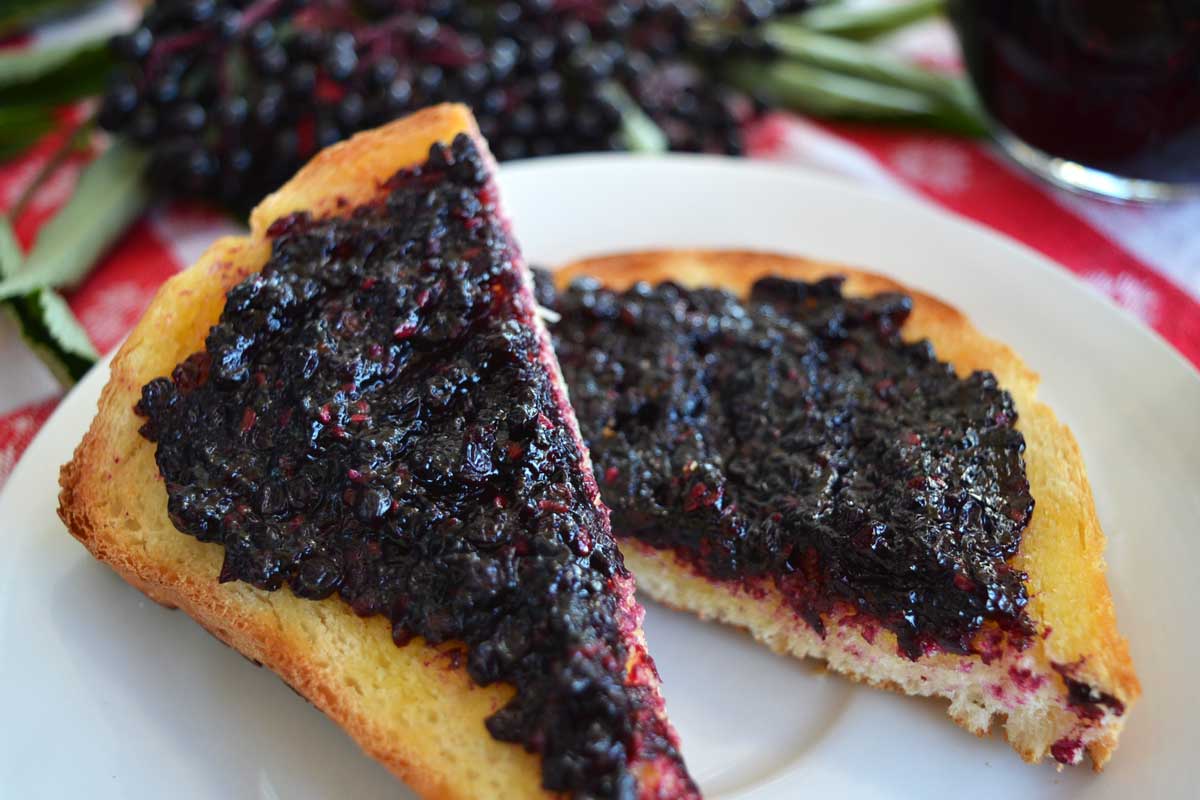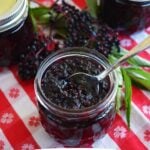Easy Elderberry Jam Recipe with Less Sugar
This post may contain affiliate links. Read my full disclosure here.
This easy elderberry jam recipe helps you turn your berry bounty into a chunky spread with less sugar. I like to use Pomona’s Universal Pectin for quicker cooking, but we also include directions with no added pectin.

Not a fan of seeds? Check out our elderberry jelly recipes.
Where to Get Elderberries
You may be able to forage for wild elderberries. American black elderberries (Sambucus canadensis) grow in USDA hardiness zones 3-9. Sambucus nigra is native Europe, western Asia, and northern Africa.
Learning to forage for wild plants is a great way to stretch your budget and increase your resilience. You can learn more about finding wild elderberry plants here.
Elderberries are also fairly easy to grow, and ornamental. The bright flower clusters attract pollinators, and the black berries hang in bold clusters. See “How to Grow Elderberries for Food and Medicine” for growing tips and recommended varieties.
More people are starting to grow the berries as their popularity increases. It’s worthwhile to do a search for local growers. Though we have our own patch, I was pleasantly surprised to find a local grower with over 6000 elderberry plants!
Finally, if you can’t find them locally, you can order dried or frozen raw elderberries online.
Elderberry Jam Recipe
Fresh or frozen elderberries are easiest to use for this recipe. If you only have dried elderberries, cover them with water and soak overnight. Personally, I’d use the dried berries for elderberry syrup instead.
Ingredients
- 4-5 cups fresh or frozen elderberries (cleaned, stems removed) – about 20-25 ounces
- 1/4 cup lemon juice
- 2 teaspoons calcium water – included in the packet of Pomona’s Pectin
- 1 cup granulated cane sugar
- 2 teaspoons of Pomona’s Universal Pectin
- 1/2 teaspoon ground cinnamon (optional)
Instructions
Prepare fresh elderberries by washing and removing all the stems. Thaw frozen berries. Prepare your water bath or steam canner, jars, and canning lids.
Mix up the calcium water according to the package directions included with Pomona’s Pectin. In a large saucepan, combine the cleaned elderberries, lemon juice, and calcium water.

Bring the mixture to a boil, then reduce the heat. Let it simmer for about 5-10 minutes, or until the berries soften and start to break down. Use a potato masher or the back of a spoon to gently mash the berries, releasing more juice.
For a smoother texture, strain the mixture through a sieve to remove the seeds and skins. This is optional, and reduces the yield of jam. If you’d like to go seedless, I’d suggest starting with eight cups of raw berries.
Add the pectin powder to the sugar and stir to combine. Stir in the sugar and pectin mix (and cinnamon, if using) into the berries and mix until dissolved. Bring the mixture to a boil and cook for one minute; remove from heat.
Pour the warm jam into sterilized jars, leaving one fourth inch headspace. Seal the jars with lids. For long term storage, process the jars for 10 minutes in a water bath or steam canner.
Remove the jars from the canner and cool completely. Check seals, date and label. Store jars in a cool, dark location, out of direct sunlight.
Would you like to save this?
For best quality, use within 18 months. Once opened, refrigerate and use within a few weeks. If you don’t want to bother with canning, store your filled jars in the refrigerator.

If you want to skip the pectin
Elderberries are low in pectin, so adding commercial pectin helps the jam set up. I choose Pomona’s Universal Pectin because it sets up using calcium instead of sugar. This allows us to use less sugar, or no sugar at all. (Learn more about Pomona’s Pectin, and how pectin works.)
If you don’t want to use commercial pectin, ignore the part of calcium water and adding pectin. Cook the berry-sugar mixture over low heat, stirring frequently, for another 10-15 minutes, or until the mixture thickens.
To check if the jam is ready, place a small spoonful on a cold plate. If it wrinkles when you push it with your finger, it’s done. If not, continue simmering for a few more minutes and test again.
Sugar Substitutions
Because Pomona’s Pectin gels using calcium instead of sugar, you can substitute other sweeteners. Honey is about twice as sweet as granulated sugar, so use about half as much.
Maple syrup, date sugar and other natural sweeteners also work, and add their own unique flavors. You can also use zero calorie sweeteners like Swerve.

Serving Suggestions
- Spread: Slather elderberry jam on toast, bagels, or biscuits for a tart and sweet morning treat.
- Pair with Cheese: Elderberry jam pairs beautifully with cheeses like brie, camembert, or sharp cheddar, making it perfect for charcuterie boards.
- Desserts: Add a spoonful of jam to yogurt, pancakes, waffles, or ice cream for a fruity twist.
- Sauces and Glazes: Mix elderberry jam with vinegar or mustard to create a flavorful glaze for meats like pork or chicken.
Health Benefits of Elderberries
Elderberries, particularly those from the Sambucus nigra species, have been used in traditional medicine for centuries. They’re packed with antioxidants, vitamins (like vitamin C), and flavonoids. These contribute to their immune-enhancing and anti-inflammatory properties.
Note: Raw elderberries contain cyanogenic glycosides, which can cause stomach upset. The good news is that cooking breaks these down, making the berries safe to eat. (The stems have more of these compounds.)
Even better news is that Sambucus canadensis varieties have less of these compounds than their European cousins. This makes the berries safe to eat raw for most people. Sensitive individuals may still have a reaction, so it’s best to cook the berries before eating.
PrintEasy Elderberry Jam Recipe with Less Sugar
This rustic elderberry jam recipe uses less sugar, so the berries are the star of the jam.
- Prep Time: 10 minutes
- Canning Time: 10 minutes
- Cook Time: 10 minutes
- Total Time: 30 minutes
- Yield: 4 cups 1x
Ingredients
- 4-5 cups fresh or frozen elderberries (cleaned, stems removed) – about 20-25 ounces
- 1/4 cup lemon juice
- 2 teaspoons calcium water – included in the packet of Pomona’s Pectin
- 1 cup granulated cane sugar
- 2 teaspoons of Pomona’s Universal Pectin
- 1/2 teaspoon ground cinnamon (optional)
Instructions
- Prepare fresh elderberries by washing and removing all the stems. Thaw frozen berries. Prepare your water bath or steam canner, jars, and canning lids.
- Mix up the calcium water according to the package directions included with Pomona’s Pectin. In a large saucepan, combine the cleaned elderberries, lemon juice, and calcium water.
- Bring the mixture to a boil, then reduce the heat. Let it simmer for about 5-10 minutes, or until the berries soften and start to break down. Use a potato masher or the back of a spoon to gently mash the berries, releasing more juice.
- For a smoother texture, strain the mixture through a sieve to remove the seeds and skins. This is optional, and reduces the yield of jam. If you’d like to go seedless, I’d suggest starting with eight cups of raw berries.
- Add the pectin powder to the sugar and stir to combine. Stir in the sugar and pectin mix (and cinnamon, if using) into the berries and mix until dissolved. Bring the mixture to a boil and cook for one minute; remove from heat.
- Pour the warm jam into sterilized jars, leaving one fourth inch headspace. Seal the jars with lids. For long term storage, process the jars for 10 minutes in a water bath or steam canner.
- Remove the jars from the canner and cool completely. Check seals, date and label. Store jars in a cool, dark location, out of direct sunlight.
- For best quality, use within 18 months. Once opened, refrigerate and use within a few weeks. If you don’t want to bother with canning, store your filled jars in the refrigerator.
Notes
If you don’t want to use commercial pectin, ignore the part of calcium water and adding pectin. Cook the berry-sugar mixture over low heat, stirring frequently, for another 10-15 minutes, or until the mixture thickens.
To check if the jam is ready, place a small spoonful on a cold plate. If it wrinkles when you push it with your finger, it’s done. If not, continue simmering for a few more minutes and test again.
More Elderberry Recipes
We have our own elderberry patch, so we have enough berries to share with friends and try different recipes. These are some of our favorites:
- Elderberry syrup with fresh or dried berries
- Easy Elderberry Gummy Recipe
- How to Make Elderberry Wine
- Elderberry Jelly – Low Sugar and Traditional Recipes

This article is written by Laurie Neverman. Laurie was raised on a small dairy farm in northwest Wisconsin, where she gathered wildflowers from the woods and pastures. She and her family now live in northeast Wisconsin, where they combine intentional plantings and semi-wild areas. Every season is a new opportunity to learn more about working with wild plants.



Hey, your printable recipe calls for tablespoons and not teaspoons. I use Pomona’s regularly and had to view your video to make sure it was a typo. Thanx for the recipe.
Thank you!